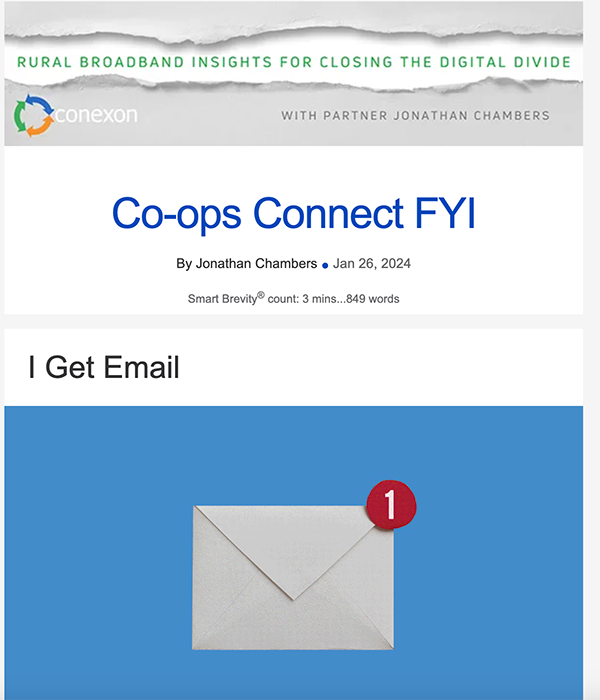I Get Email
January 26, 2024
When I started blogging about broadband a decade ago, I never enabled comments. I’m sure there are thick-skinned writers who can tolerate the dreck that comments sections often produce, especially anonymous comments. I know that I am not one of them.
Using this format has had an unexpected benefit: I receive occasional emails in response to my writing that are well worth reading.
I thought I’d share a few of those emails this week.
The End of the Affordable Connectivity Program
In response to my suggestion that the FCC reform Lifeline to provide affordable broadband as the ACP runs out of cash, a former colleague sent me this note:
I saw your recent editorial on how Lifeline is a ready-made program that could be modified to meet a similar level of recipients as ACP. I am working with a broad group of stakeholders that are of a like mind…
Why it matters:
His email prompted me to call him; we spoke and decided to file an emergency petition with the FCC. The petition has been drafted and I expect we will file it within two weeks.
I will keep the co-op community apprised as to how we might move this important initiative forward.
The Right Approach for Rural America
Otsego Electric Cooperative (OEC), in upstate New York, was one of our first fiber projects. Their CEO, Tim Johnson, recently wrote to share this recollection:
I looked back at the ~2010 Otsego County feasibility study [conducted by the County]. It called for a hybrid fiber/wireless system, so someone was going to get the very short end. Total cost at the time was $30 million. Ten new towers (never would have been enough to cover the hollows) and only 211 miles of new fiber. Somehow bringing in 9,000 fiber drops and about 10,000 fixed-wireless locations.
Our total public money to date at OEC is $21 million, with local of over $9 million to get FTTH and the best service in the county to our subscribers with about 6,000 passings and relatively small incremental costs to get to a couple thousand more with the existing backbone. Crazy.
(emphasis added)
Why it matters:
When I first met with OEC board in 2016, they were a skeptical group. OEC was to be Conexon’s first full network design and construction project. At the time, Conexon was just Randy Klindt and me. Moreover, the fiber-to-all-members approach we presented to the board was decidedly different than everyone else’s advice.
- It took trust, success in the grant process, and a lot of hard work by Tim and his team. Their accomplishment has been and continues to be remarkable.
- While the success of a fiber-to-all-members approach has now been repeated by scores of other electric co-ops, those early successes remain the sweetest.
Over the years, I’ve often heard WISPs plaintively suggest that I don’t understand the benefits of fixed wireless or hybrid fiber/wireless networks.
To the contrary: I do understand their benefits — and I also know their limits. I’ve encountered far too many co-ops who were misled by the claims of fixed-wireless consultants and vendors.
The bottom line:
We continue to replace co-op fixed-wireless systems with fiber networks, at lower costs and far greater capabilities than the original wireless systems.
The Rebranding of the Fiber-to-the-Home Council
I don’t always expect readers to agree with what I write or my point of view. I write to provoke.
I told Gary Bolton of the Fiber Broadband Association that I would print his statement to correct one of my recent points that he shared in an email to me:
I saw the article below and wanted to alert you that your statement on FBA’s rebranding years ago is incorrect. Nearly a decade ago, the FTTH Council rebranded to the Fiber Broadband Association to be more inclusive of all Fiber Broadband applications (not just FTTH). This includes Middle Mile fiber networks and the In-Home Experience. While a number of WISPs have joined FBA, they joined as they are deploying FTTH networks to transition their FWA customers to fiber for a better quality of experience and to improve their customer retention (and reduce the number of support calls).
Why it matters:
My recollection of the rebranding is different.
- As a policymaker, I valued the positions taken by an association that was focused solely on fiber to the home.
- As public money was being allocated to rural broadband, I thought it important that there continue to be a singularly focused voice for last-mile fiber.
- At that time, I felt that the rebranding led to a shift in focus, and that shift in focus diluted its valuable advocacy for rural fiber networks.
The bottom line:
Despite what I feel, I do believe Gary is right in representing his association in the way he thinks best.
The Final Word
I have received many emails expressing appreciation that I’ve begun writing again.
Thank you for the encouragement.
